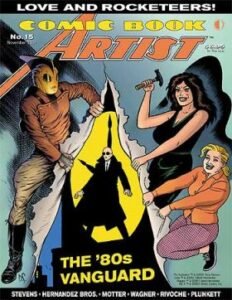Comic Book Artist #15 November 2001 (magazine review).
This turn-of-the-century ‘Comic Book Artist’ had the sub-title ‘The ‘80s Vanguard’, as it looks at some of the creators who worked in the independent comics of that time. There’s an extensive interview with comic book artist Dave Stevens (1955-2008) by editor Jon B. Cooke that fills me in on his history and art up to that point. Although I watched and enjoyed ‘The Rocketeer’ film, I’ve never gotten around to reading his comic books.
After reading the history of how his mini-series was published by various independent comic book companies, I am less surprised that I missed them while living in the UK. I do like his art, though, as shown here, so I should be seeking it out. Surprisingly, he never considered himself a creator, initially focussing on animation layouts and occasional inking work, before beginning with a few 8-page fillers that proved to be successful.
Reading here, ‘The Rocketeer’ was practically a casual evening job. I suspect without this, the series would never have happened. Today, comic book companies should consider running trial comic books to provide opportunities for new concepts, artists, and writers, allowing them to discover promising ideas that potential fans can embrace as they emerge.
I’ve never read any of the Hernandez Bros.’s output, although I was surprised to find their “Love & Rockets” didn’t last that long. Out of the Hernandez family, only three of the brothers got into comics, mostly from their love of comics by their mother and themselves. Their night-worker father thought keeping them drawing would keep them quiet during the day. None of them thought they would ever break into the business. Chris Knowles interviews Mario, Gilbert and Jaime separately and builds up a picture of their early lives and how they recognised each other’s talents. Oddly, none of them go into great detail explaining their output, but I am a sucker for interviews. Jaime centres more on his work than his early life and why ‘Love & Rockets’ lost his interest and showed up in his work.
The interview with creator Matt Wagner about his work on ‘Grendel’ and ‘Mage’ ended up centring more on the independent comic book companies of the 1980s. It also gives some insight into the American business world and the need for people business-trained to run these companies. If anything, there were elements of naivety and expanding too quickly rather than on a better financial basis. Additionally, it is important not to let your personal characteristics be perceived as part of the company.
Another character I’ve never read is Mister X. Here we have two interviews. The first interview features his creator, designer, and writer, Dean Motter, who discusses his career in album covers and the process of creating the comic book in Canada. The second with its first artist, Paul Rivoche, which gives an impression of how small a professional art community they had in Toronto. At least there was a little more information about Mister X himself. Although I can understand Rivoche’s apprehension over Mister X’s addiction to drugs to keep himself awake at night, I do have to wonder what he would think of Sherlock Holmes, who did far worse.
Lastly, an interview with Sandy Plunkett by Tim Barnes covers his history and why he was moving away from comic books at the time. Looking back with hindsight now, it looks like he made the right decision.
As always, for a magazine devoted to comic book artists, there are more interviews than art at this time but enough to satisfy those who want to be reminded of what they did at the time. What is important is that if you’re into the independent comics of the 1980s, this issue will provide you with some entertaining knowledge.
GF Willmetts
May 2025
(pub: TwoMorrows Publishing. 114 page illustrated magazine. Price: $ (US). ISSN: 401-783-1689. Direct from them, you can get it digitally for $ 5.99 (US))
check out websites: www.TwoMorrows.com and https://twomorrows.com/index.php?main_page=product_info&cPath=98_56&products_id=531







